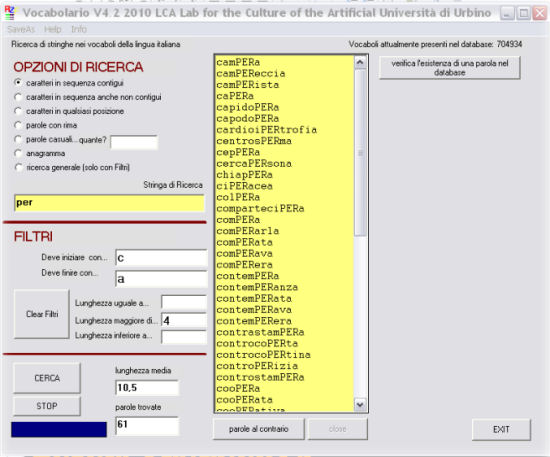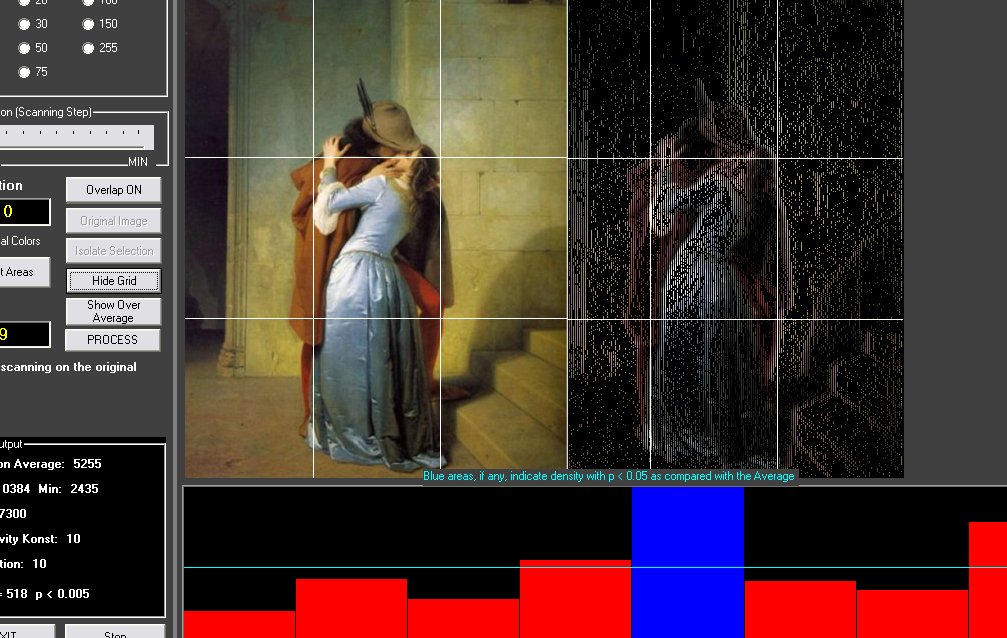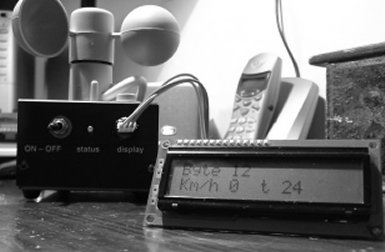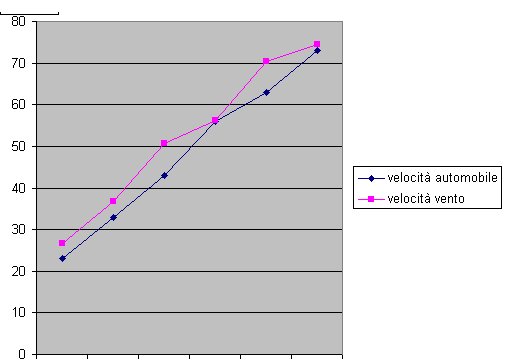software/hardware
Ask Software or Demos to massimo.negrotti@libero.it
| Recent
software/hardware |
|
| for Windows ME, 2000, XP, Windows 7 |
Ask Software or Demos to massimo.negrotti@libero.it |
Parole Italiane 4.2 (2010)
Colour Variations 3.0 (2011) NEW!
PolySens 1.2 (2002)
Color_Sound 1.1 (2003)
NutSim 2.0 (2003) NEW!
Mediar 2.1 (1998)
MatrixSim 1.1 (2003) NEW!
Anemometer 1.4 (2004)
TripChecker 1.0 (2004) NEW!
AutoPhoto 1.0 (2005)
Trip_Ranger 1.0 (2007) NEW! Ricordo di mio padre, Aldo Negrotti (1921-2005)
CellMax 1.1 (2007) NEW!
Parole italiane 4.2

Sulla base di oltre 700000 vocaboli, ParoleItaliane cerca i termini che rispondono ad una serie di filtri:
sottostringhe in tutte le posizioni, iniziali, finali, lunghezza, rime, ecc.
Colour Variations 3.0

Colour Variation è programma informatico progettato in via sperimentale dall’LCA – The Lab for the Culture of the Artificial
– presso l’Università di Urbino. Il programma in questione consente di analizzare un’opera pittorica per verificare se sono presenti
aree in cui l’artista sembra aver maggiormente insistito sotto il profilo tecnico. In altre parole, Color Variations individua e
conteggia il numero di ‘variazioni di colore’ all’interno di aree del dipinto la cui ampiezza è stabilita dall’analista. Con qualche
approssimazione, il numero di variazioni può essere assunto come numero di pennellate. In effetti, mentre l’assenza
di variazioni in una certa area non significa necessariamente assenza di pennellate multiple, è certo che N variazioni indicano almeno
N pennellate.
Un test di significatività statistica (χ Quadrato), infine, permette di stabilire se la presenza di un maggior numero di pennellate
in una o più aree sia da intendersi come casuale oppure no. In questo ultimo caso, è plausibile pensare che l'artista ritenesse
di dover risolvere un problema stilistico o se, comunque, si trovasse di fronte ad una sorta di nodo cruciale per la buona riuscita dell’opera.
<< Non c’è dubbio che si tratta di uno strumento che può rivelarsi estremamente utile agli storici e ai critici poiché può essere utilizzato
nell’analisi di opere sia di arte figurativa sia non figurativa, vale a dire da tutti coloro che hanno il compito di studiare e interpretare
l’intenzionalità e gli obiettivi dell’artista. Il programma in questione può rivelare la sua utilità metodologica non solo come sostegno
dell’interpretazione critica, ma anche come punto di partenza esplorativo. Infatti, la scoperta di possibili ‘punti culminanti’,
– per usare le parole di Rudolf Arnheim - sempre e comunque presenti nell’opera, verrà di fatto resa più agile, consentendo
la produzione di ipotesi i cui presupposti sono latenti nel lavoro dall’artista stesso. >>
Danila Bertasio,
Docente di Sociologia dell'Arte
Università di Parma
New! Programmazione del Modulo Speech Synthesizer Davantech SP03 attraverso
il protocollo I2C e un controller BX24.
PolySens© 1.2
Captures up to 16 analog/digital signal from
the external world through an ad hoc card based on a Parallax BS2-Ic
microcontroller. Data are transferred to the
PC through RS232 protocol.
In the current application, PolySens captures
data from 4 light sensors (photocells) placed on a box at the North,
South East and West directions. Then, PolySens
draws the 'Dynamic Light Image' of the environment it is placed in,
thus describing a storm or a sunny day, movements
of objects or people, etc.
| data are displayed both as graphic curves and areas whose dimensions are proportional to the intensity of light |
Color_Sound 1.1
Picks points within an image (in JPG format)
and transduces them in sounds according the RGB values of those points.
The user can select the density of the points
matrix, the tempo of the resulting music execution, the musical instruments
and other parameters.
| the image is scanned according to a matrix whose
density is selected by the user
|
NutSim© 1.3
Simulates the changes of states of a NutChip
programmable integrated circuit. It includes the 4 digital Inputs, the
6
Remote Keys, the Timers and the 4 Outputs.
In addition to the comments to each change of state, user can also
comment each Output. A real-time report of
the changes of states is also provided.
|
changes of states are shown both as light On/Off
and as a Progress Report
|
Mediar 2.1
MEDIAR, designed for NoteBooks, is useful
and amusing for driving a car, a camper, etc. – particularly if
assisted by a ‘navigator’ travelling with
you - when you have to cover long distances and want to regulate
your speed in order to arrive at the planned
time.
MEDIAR calculates your speed average and,
on its basis, predicts the time of your arrival.
If the predicted time is not right for you,
MEDIAR is also able to calculate the average speed you should
maintain in order to arrive at the desired
time.
| a lot of information is provided to the driver
with only one input.
The NoteBook can also be switched off between two consultations. |
MatrixSim 1.1
| MatrixSim 1.1 has been designed to simulate a table of matrix displays (we name the table 'Matrix') having in mind a popular Device, namely the Kingbright 18mm (0,7 Inch) which comes both in Red and Green color. MatrixSim 1.1 allows to design Matrix in different size: from 1 to 50 Devices, selecting colors like red, yellow, green or blue. MatrixSim will also produce, for every Matrix, the complete Table of the Logical State of each LEDs Device. From the Table, one can derive the driving strings for ICs dedicated to driving the Devices rows (max 5 * 7 = 35 cathods/anods) and Devices columns (max 10 * 5 = 50 cathods/anods). MatrixSim 1.1 includes also an Animation tool which allows to build a 'movie' of Matrixes. It is also possible to 'imprint' a black and white picture (format .bmp) on the Matrix, getting automatically, this way, the Table of LEDs Devices logical state. |
|
|

Measures the speed ofthe wind and stores data into a 32KBytes EEProm. Sampling frequency can be programmed from a minimum of 1 sec. ad libitum. Then, data can be transferred to a PC which, thanks to a dedicated software, draws graphics with and without smoothing.

Correlation between speed of the wind and
speed of a car
TripChecker © 1.0
 |
This is a very personal gadget, since it adapts itself to your preferred or habitual travels as well as to the average speed you keep during a trip. You should enter into TripChecker© up to 800 legs at your choice, along with the distance between the starting point and the arrival of each leg. You may also create your own database for different areas by means of an ad hoc PC software, transmitting the database to the TripChecker© through the serial port. Then, you may plan a trip selecting the legs included in it. During the travel, TripChecker© will display the distance which remains to cover and the time needed to reach the next arrival point. To do so, TripChecker© uses the average speed you obtained the last time you did the same legs, or, by default, 50 Km/h for regular ways and 100 Km/h for the freeways. When you get the arrival point of a leg, you need to press the button ‘STORE’ and TripChecker© will recalculate the average speed for that leg. If you stop for whatever reason, the device will stop too thanks to a moving sensor. This means that TripChecker© will only take into account the actual moving speed. TripChecker© is rechargeable batteries operated (through a cable plugged into the device) and, due to the very low power needed, it can guarantee continuous operation for 70-80 hours.
|
| AutoPhoto 1.0 | |

|
Thanks to the logic tables of
NutChip ( Go to NutChip's
OFFICIAL SITE ) this project allows to
capture pictures (or make movies) automatically with a rather wide frequency
(from one picture every 6 seconds to one every day and even with a mix of
intervals). Of course, it's possible to begin the capturing process after
some delay, stopping it for some time and then resume it, and so on.
The NutChip controls the on/off of the camera and the shutter through a 4016
digital switch. The digital camera is an Oregon Scientific Dshot II with a 16MBytes of SmartMedia card. In basic quality the device can program about 180 pictures. AutoPhoto 1.0 is very useful for monitoring changes of any object, e. g. weater, car and people traffic and to aid biologic or sociologic visual investigations. |
| Trip Ranger 1.0 | |
   |
By means of a few, simple connections
with a BS2 microcontroller, a CMPS03 digital compass takes the Bearing - in
RAD - during a trip (2 measures every second) storing them in EEProm of 64
KBytes. After the arrival, the user can transmit the data to an ad hoc
VB software which process them and displays graphically the trip, along with
distances and average speed (distance is entered by the user before the
trip, of course). The accuracy of the graphics depends not only on the accuracy of the compass, but also on the speed taken in the various steps. Steps of same distance can be drawn in different length due to the difference of the speed. A special routine within the VB program tries to compensate these differences on the basis of the maximum speed kept during the trip.
|
| CellMax 1.1 | |

|
Someone moves the egg? CellMax calls my mobile phone number! |
|
MaxBox 1.0
|
VMusic 1, Picaxe 18x microcontroller and a Pendrive 16 GBytes. The Box plays randomly classic music, songs, jokes and aphorisms, with random silence intervals. |
- BACK -